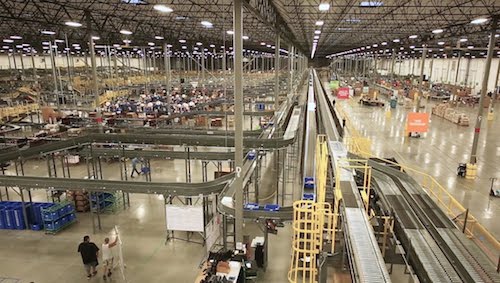
Conveyors in a Zulilly fulfillment center.
An article this weekend in the New York Times put a spotlight on the growing demand for warehouse and distribution center workers in US e-fulfillment hubs. Shiny new fulfillment centers built by Zulilly, Amazon and WalMart (among others) are creating thousands of new jobs in the shadows of shuttered manufacturing plants in places like Bethlehem and Allentown, Pennsylvania. But there is another side to this story. That other side is illustrated by existing DCs like the True Value Allentown facility I visited last week as part of a WERC DC Tour. Participants in that tour heard how process improvements and technology investments have helped reduce costs and improve distribution center productivity.
There are scores of “legacy” DCs surrounding the new ecommerce facilities. Like the new ecom fulfillment centers, many of these established sites are also adding workers and increasing wages. The older facilities have the added challenge of adapting old buildings, systems, and processes to new market demands. A recent Employment Outlook Survey conducted by the publishers of CSCMP’s Supply Chain Quarterly shed some light on these labor challenges. According to the survey, 90% of DC managers say it is getting harder to hire hourly workers. Nearly one in five of the survey respondents said they have increased hourly wages more than 10 percent.
Priorities For Improving Distribution Center Productivity
Beyond the hiring and wage data, the survey also sheds light on the top priorities for improving distribution center productivity. The Times article focused on some of the advanced automation in the new facilities, but automation is not the top priority for most DCs. The survey indicated that the majority of companies are putting their time and money into process improvement and software solutions. Those solutions range from warehouse management (WMS) and labor management systems (LMS) to mobile applications and mobile work execution software like that used at True Value. These software investments allow DCs to handle increased shipping volumes without adding headcount. The Times article pointed out that the brand-new facilities are adding hundreds of new employees working alongside the latest material handling automation systems.
This is good news for DC workers. Jobs are plentiful and distribution center productivity is rising due to the investments at new and existing facilities. Those productivity gains help support increased wages for hourly employees. There may come a time when robotics and automation advance to the point where DC jobs are reduced, but that is still far in the future. And continuing investments in productivity software for hourly employees helps preserve some of the advantages of people over machines – both in new and old facilities.
The complete Employment Outlook Survey results are being published this week. Lucas is going to dive into the numbers in our next Perfect Order Webinar on November 15th. We will send a copy of the survey report to everyone who registers for the webinar. Register for the webinar now using this link.





